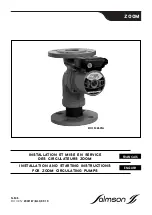
OM-06789
10 SERIES
MAINTENANCE & REPAIR
PAGE E - 7
(11, 12, 14 and 15) securing the pump casing to
the rollover base (9).
(Figure 2)
Support the pump casing using a suitable hoist
and sling. Remove the nuts (7), and separate the
pump casing (1) from the intermediate (9) by pull
ing the casing straight away. For ease of reas
sembly, tie and tag any leveling shims used under
the casing mounting feet.
Remove the casing gaskets (14). Clean the mating
surfaces of the intermediate and pump casing.
Impeller Removal
(Figure 2)
To loosen the impeller (13), tap the vanes of the im
peller in a counterclockwise direction (when facing
the impeller) with a block of wood or a soft‐faced
mallet.
Be careful
not to damage the vane. Un
screw the impeller and replace it if cracked or badly
worn. Use caution when removing the impeller;
tension on the seal spring will be released as the
impeller is unscrewed.
Slide the impeller adjusting shims (12) off the im
peller shaft. Tie and tag the shims or measure and
record their thickness for ease of reassembly.
Seal Removal and Disassembly
(Figures 2 and 3)
Remove the spring retainer (11) and seal spring.
Slide shaft sleeve (8) and rotating portion of the
seal off the shaft as a unit. Apply oil to the sleeve
and work it under the bellows. Slide the rotating
portion of the seal off the sleeve.
To remove the stationary seat and O‐ring, remove
the hardware (5 and 6), and slide the stationary
portion of the seal and intermediate (9) off the shaft
as a unit. Position the intermediate on a flat surface
with the impeller side down. Use thumb pressure
to press the stationary seat and O‐ring from the in
termediate.
If no further disassembly is required, see
Seal
Reassembly and Installation
.
Seal Reassembly and Installation
(Figures 2 and 3)
Inspect the engine crankshaft for damage. Small
scratches or nicks may be removed with a fine file
or emery cloth. If excessive wear exists, the shaft
will have to be replaced in the engine (refer to the
engine service manual).
Clean the seal cavity and shaft with a cloth soaked
in fresh cleaning solvent.
Most cleaning solvents are toxic and
flammable. Use them only in a well ven
tilated area free from excessive heat,
sparks, and flame. Read and follow all
precautions printed on solvent contain
ers.
The seal is not normally reused because wear pat
terns on the finished faces cannot be realigned
during reassembly. This could result in premature
failure. If necessary to reuse an old seal in an emer
gency,
carefully
wash all metallic parts in
fresh
cleaning solvent and allow to dry thoroughly.
Handle the seal parts with extreme care to prevent
damage. Be careful not to contaminate precision
finished faces; even fingerprints on the faces can
shorten seal life. If necessary, clean the faces with a
non‐oil based solvent and a clean, lint‐free tissue.
Wipe
lightly
in a concentric pattern to avoid
scratching the faces.
Inspect the seal components for wear, scoring,
grooves, and other damage that might cause leak
age. Clean and polish the shaft sleeve, or replace it
if there are nicks or cuts on either end. If any com
ponents are worn, replace the complete seal;
never mix old and new seal parts
.
If a replacement seal is being used, remove it from
the container and inspect the precision finished
faces to ensure that they are free of any foreign
matter.
To ease installation of the seal, lubricate the O‐ring
and shaft sleeve with water or a very
small
amount
of oil, and apply a drop of light lubricating oil on the




































